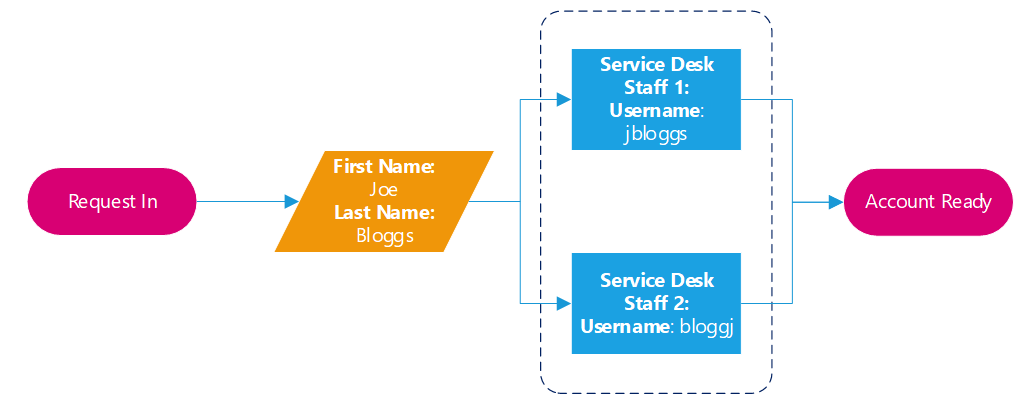Recently I have been working with a financial industry customer who is all in on Automation, however it became apparent quite early on that they haven’t standardised their processes. Now, in day to day running’s and operations of a business – particularly IT – this might not be a problem, but when you want to start automating, a lack of standards begins to complicate things. In the below article we will take a look at a process that hasn’t been standardised, and then compare it to the same process with some standards applied. We will then go on to discuss how much simpler it is to automate a standardised process.
#Non-standardised Process 1 – Creating a new user
This process creates a new user, currently there are three ways someone can request a new account, and as we can see the information can arrive staggered, each of the yellow block. This results in multiple edits and updates before the account is ready for handover.
This staggered process also introduces the risk of error, for example, the request received via the phone might result in the incorrect spelling of a surname which then requires more edits to the user account.

On top of the different ways the process can be run, we also have no naming standards within this process, for example;
- A new user request comes in with the first name and last name details of Joe Bloggs
- Service Desk Staff 1 generates the username of: jbloggs (first name initial and full last name)
- Service Desk Staff 2 generates the username of: bloggj (first five characters from last name and first name initial)

#What is a Standard
Standardisation is a set of rules and agreements that all users or consumers must adhere to, so that all processes are equal and meet set guidelines. This ensures that the end product has consistent quality and that any conclusions made are comparable with all other equivalent items in the same process. Standardisation is achieved by setting generally accepted guidelines with regard to how a product or service is created or supported, as well as to how a business is operated or how certain required processes are governed. The goal of standardisation is to enforce a level of consistency or uniformity to certain practices or operations within the selected environment.
(Reference: https://www.investopedia.com/terms/s/standardization.asp)\ (Reference: http://www.qualityindustries.com/news-and-events/2015/06/30/five-benefits-of-standardized-work.1652673)
#Standardised Process 1 – Creating a new user
This is the same process as we saw earlier, but we have now applied standards. All requests for a new user must come in through a form, and this form has data fields that the requester must complete before submitting.
This now ensures that all data required for a user account arrives at once, and because it is via a typed form, we avoid the issues of misinterpretation that we had earlier with the first & last name spelling.
The new process reduces the number of edits and ultimately results in the requester getting their end product – the user account – much sooner.

In the previous non-standardised process, we also had the differences in naming standards, these have now changed and all users created are in the format of: first initial and full last name.

#Automating Process
When automating a process, we can see how standards simplify the task. Without standards we would need to account for every scenario that the request could follow, allow for breaks in the process, enable human interaction, and provide error correction. With standards we can allow automation to generate the username, validate the inputs and hand over the item to the requester.
When we have standards, estimating the time required for automation also becomes simpler, we have a clearly defined process with a set of inputs (the user details) and an expected outcome (the user account).
Once the process is standardised, and automated, changes to this process become more controlled – we can introduce and enforce a review process which means any changes to the process are agreed within the team and released in an agreed manner.
#How Can You Standardise?
This is a very simplified approach, but it’s a great start for introducing standards.
- Identify the core processes owners
- These are the people that run it day-to-day (e.g. service desk staff)
- Hold a process review workshop with the process owners
- Include someone who can moderate the meeting and create agreement between the team
- Whiteboard the process, get each owner to do it to highlight any differences
- Like the non-standardised flow diagrams above, this will show differences amongst the team
- Remember that because process owners might have their own view on a process, they aren’t wrong
- Identify the following information for the process
- Process Inputs (what information is needed for the process to run, this can be from both users and other systems)
- Process Outputs (what is the end product of the process, what does the requester get at the end)
- Error handling (what happens in an error occurs at each of the steps)
- For any process inputs, try to identify standards within those
- Naming standards, for example, username generation
- As an outcome, you should have one documented process that has been agreed by all process owners, this is your new standard
- Try to identify how this will be rolled out to the business and enforced – this is important, otherwise your standard will collapse again!




